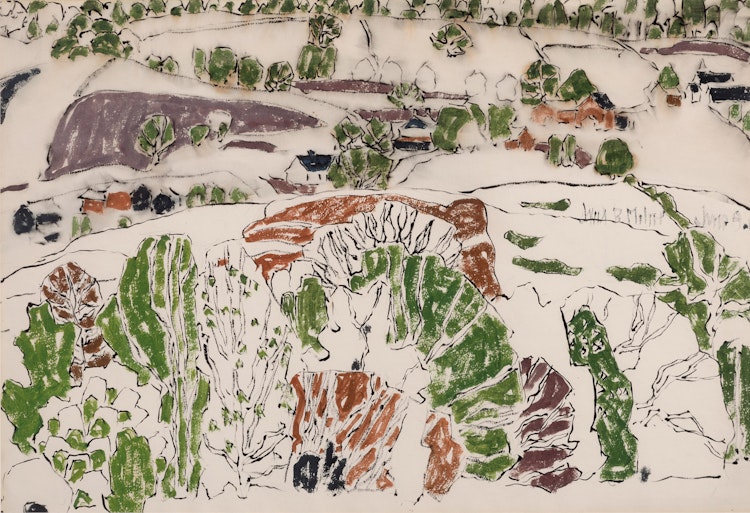Green and Brown, Boston Corners, 1917 by David Brown Milne

David Milne
Green and Brown, Boston Corners, 1917
watercolour
signed and dated "June 9, 1917" at right edge; inscribed "Green & Brown" (by Patsy Milne) on the reverse; inscribed "EW #17 David Milne: Boston Corners: Purple and Green" (by Douglas Duncan) on the old mat attached to the reverse; catalogue raisonné no. 107.88
15.25 x 22.25 in ( 38.7 x 56.5 cm ) ( sheet )
Auction Estimate: $60,000.00 - $80,000.00
Price Realized $102,000.00
Sale date: May 28th 2025
Douglas Duncan, Picture Loan Society, circa 1962
Private Collection, Whitehorse, Yukon
David Milne Jr. and David P. Silcox, "David B. Milne: Catalogue Raisonné of the Paintings, Volume 1: 1882-1928", Toronto, 1998, listed and reproduced page 182, no. 107.88
Katharine Lochnan, "David Milne Watercolours: Painting Toward the Light", Toronto, 2005, pages 44, 53
Sarah Milroy and Ian A.C. Dejardin, "David Milne: Modern Painting", London, 2018, pages 17-22
For the eighteen months following their move, Milne found all of his watercolour subjects within a few miles of his house. They were painted "en plein air", often with a graphite sketch beneath the pigment, and Milne claimed not to alter them once they were done. He painted many pictures of the same subjects; they are both variations on a theme and an obsessive search for what he considered perfection. Milne wrote of the Boston Corners years: “Painting subjects were scattered all over the place but rarely were more than two miles away. All were painted on the spot, and then, good or bad, left alone; no attempt was made to develop or change or repaint after the original painting was done. [...] The radius of my painting was determined by time, load and frame of mind. If my attention hadn’t escaped from the round of day by day events and become fixed on painting subjects and painting methods within the leisurely two-mile walk, it wasn’t apt to that day.”
"Green and Brown, Boston Corners" illustrates the flat, pattern-like quality Milne admired in Monet and incorporated into his rural American scenes. The flattened perspective and decorative paint application on bare paper recall the fragmented landscapes of Cézanne, whose work he also admired in New York City. The watercolour is intricately and deliberately composed, while simultaneously loose and spontaneous in its line and contours. Milne’s watercolour method consisted of painting the black outlines of each form, filling some in with colour applied directly to the paper, and then adding water to the rolling hills in the background to create a soft, blended appearance.
"Green and Brown, Boston Corners" exemplifies Milne’s strong predilection for line that was given increased prominence during his early years in Boston Corners.
Share this item with your friends
David Brown Milne
(1882 - 1953) Canadian Group of Painters
Milne was born near Paisley, Ontario. A childhood interest in art, which revived while he was teaching, led him to take a correspondence course and eventually he travelled to New York City to continue his studies. This was somewhat of an exception in the early twentieth-century Canadian art scene as the majority of artists went to Europe to study. While in New York City, Milne worked as a commercial illustrator for several years before deciding to give up this work and devote his time to painting. Shortly after making this decision he moved to Boston Corners in New York.
Throughout his life Milne sought the peace and solitude of a rural life. In his paintings, Milne explored different viewpoints. He greatly admired the work of Tom Thomson but had little interest in the nationalistic approach of the Group of Seven. His themes range from landscapes to views of towns and cities, still lifes and imaginary subjects. His experiments with different media and changing viewpoints show his interest in the process of painting itself. In 1929, Milne returned to settle permanently in Canada, stopping for brief periods in Temagami, Weston, and Palgrave. He built a secluded cabin at Six Mile Lake, north of Orillia, and spent the next six years painting, for the most part, alone. Milne was interested in 'pure' painting, in "adventures in shape, colour, texture and space" as he called his watercolours of the 1930s and 1940s. The change from the less vibrant drybrush "adventures" to the fantasy watercolours is often attributed to the birth of his only child, David Jr., born to Milne's second wife when Milne was sixty. His young son encouraged him to adopt a new, vibrant and often whimsical approach to his art. Milne spent the rest of his life in Uxbridge, north of Toronto, exploring the Haliburton and Bancroft areas as well as the city of Toronto.

